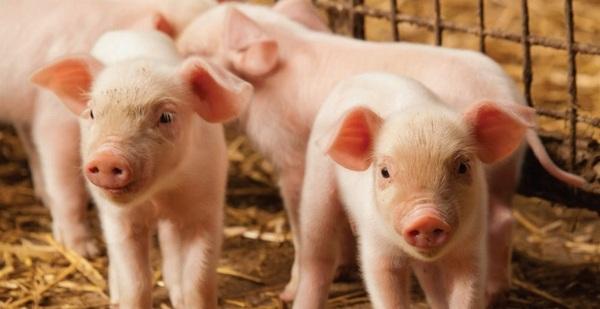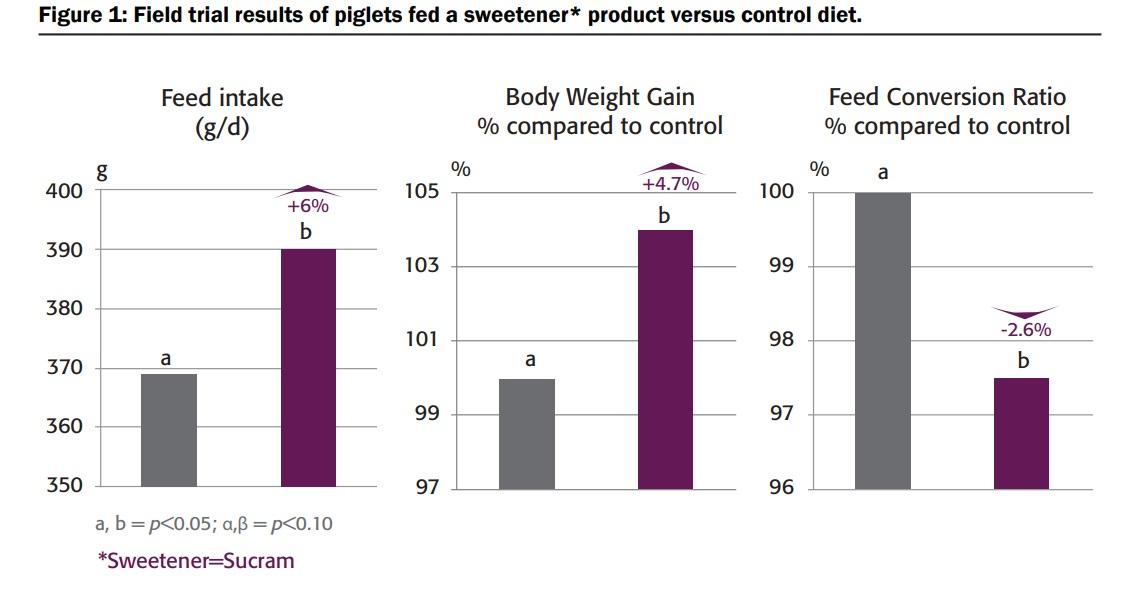Optimizing piglet performance through appetite stimulation and gut health
Published: October 1, 2019
By: Mathilde Ramillien, Product Manager Palatants –Flavorist with Pancosma, Switzerland. References are available on request to the author. Previously published in ASIAN PORK MAGAZINE – July/August 2019.

Mode of action of taste enhancers
Commonly used in feed to enhance appetite by providing an attractive taste, their function is to target the receptors of the 5 main tastes, namely: sweet, salty, bitter, acid and umami. Many tests and studies have demonstrated the positive effect on the condition of animals and consequently improved performances.
It is known that a good taste enhancer improves the taste of feed and stimulate consumption. However, some molecules, such as monosodium glutamate (umami taste), present in some product, are known to trigger a hormonal secretion (cholecystokinin (CCK) hormones) reducing animals’ appetite. Sweet flavor enhancers, such as Sucram products, do not contain them.
These sweeteners trigger the sweet taste receptors (T1R2 and T1R3) mainly known to be located on the tongue of animals, as well as humans. Nevertheless, they have also been identified in the digestive tract where they play a very important role.

The main interests are the molecular physiology and effects of the products at gut level. This process includes gut sensing, gut immunity and gut microbiota. It is what is defining ‘gut effects’ and is promoted as ‘Intelligent Gut Action’ (IGA). This phenomenon that occurs at the intestinal level has two main effects: the release of glucagon-like peptide 2 (GLP-2) and thus the secretion of the glucose transporter (SGLT-1). The GLP-2 hormone is involved in tissue repair and increases blood flow to the gut, which can improve digestion and absorption of nutrients in addition to preventing or repairing damage. Thus the release of SGLT-1 will promote glucose uptake.
Therefore, the use of a high intensity sweetener improves the integrity of the animal’s gut and the absorption of nutrients.
As this type of additive is usually incorporated at low doses, it is essential that its quality and technology ensure a good mixability and even dispersion in feed. Therefore, the technical constraints are crucial for an optimum effect: homogeneity, flowability, particle size distribution.
Improved piglet performance
Besides good quality feed, favorable housing conditions, climate and farm management a fast gut development and a good gut health are key parameters in the growing process of animals. To maximize this development from the earliest stages of the animals’ life, the diet should be attractive and palatable. A sweetened feed is more likely to be accepted by young animals when solid feeds are offered to them for the first time.
Once the feed is ingested, Sucram will first be detected by receptors on the tongue and will give the feed a pleasant taste. Then it will be able to achieve its effects on the gut.
Independent field trials of 384 weaned pigs revealed that the sweetening product increased feed consumption (+ 6%), body weight gain (+ 4.7%), and improved feed conversion ratio (-2.6%) (Figure 1).
Increased Lactobacilli
More recent trials have indicated that Sucram also has an impact on the Lactobacillus population. This is the first report of a prebiotic like effect of Sucram influencing commensal gut microbiota.
Sweetener applications and quality
Sweeteners can be used in a wide range of applications for many types of feed, such as creep feed, pre-starter, starter, milk replacer, drinking water and for several species including piglets, pigs and sows, as well as calves, beef and dairy cows. Formulations must be properly selected according to the targeted specie and local legislation. For example, a sweetener used for sows in Europe cannot be based on sodium saccharin. To fit these needs the Sucram portfolio also contains products based on natural sweeteners. Research projects to understand the specificities of sweet taste receptors in swine are ongoing.
In addition to sweet taste receptors the gut also has the ability to detect other taste compounds (umami and bitter) non-nutrients such as phytonutrients, including capsaicin (from chili peppers) and cinnamaldehyde (from cinnamon).
Related topics:
Authors:
Influencers who recommended :
Soraya Shirazi-BeecheyRecommend
Comment
Share
Universidade Federal de Viçosa - UFV
10 de octubre de 2019
Dr. Mathilde, subject of interest in pig production. Taking advantage of your understanding on the subject, I would like your opinion on the risk of NEOFOBIA, that is, appetite stimulators can have the opposite effect on piglets after weaning, reducing feed intake if the stimulator is not included in the feed. provided to these animals during lactation. And in the specific case of the effect of monosodium glutamate, the increased release of CCK, due to its recognized effect on reducing gastric emptying, would not improve the feed conversion of animals. Congratulations on the article and we await your comments.
Recommend
Reply
University of Liverpool
9 de octubre de 2019
I have been researching for Pancosma in the areas mentioned in the article above since 2008, and I am delighted to read the article. Congratulations to the author Mathilde Ramillien.
I wish to provide further background information and add relevant publications to complement the above article.
The work in my laboratory at the University of Liverpool, UK was the first to show that the sweet taste receptor, consisting of 2 subunits, Taste 1 Receptor 2 (T1R2) and 3 (T1R3) not only are expressed in the tongue, but also in the enteroendocrine (sensor) cells of the intestine (Dyer et al. 2005) and that this receptor in the gut is activated by artificial sweeteners resulting in enhancement in the activity/levels of intestinal glucose transporter (sodium/glucose cotransporter 1, SGLT1) resulting in increased ability of the gut to absorb glucose (electrolyte and water) (Margolskee et al. 2007; Dyer et al. 2007).
We identified through the research funded by Pancosma in 2008, the molecular basis of the effect of the sweetener, Sucram included in the diet of early weaned piglets in preventing diarrhoea, malnutrition and dehydration (Moran et al 2010). Furthermore, we demonstrated the mode of action of a sweetener component of Sucram, neohesperidin dihydrochacone, NHDC, in enhancing the population abundance of probiotic bacteria, lactobacillus, which enhances immunity in early weaned piglets (Daly et al. 2014, 2016).
We have shown that a key player in the pathway controlling intestinal glucose absorption is the gut hormone, glucagon like peptide-2 (GLP-2). Activation of intestinal sweet receptor by sweeteners results in secretion of GLP-2 from the enteroendocrine cells. GLP-2 increases intestinal glucose absorption and gut tissue integrity via a neuro-paracrine pathway (Moran et al 2018).
I wish to include the publications below from my laboratory which can illuminate on and add further to the very nice article written by Mathilde Ramillien from Pancosma.
Glucagon-Like Peptide-2 and the Enteric Nervous System Are Components of Cell-Cell Communication Pathway Regulating Intestinal Na+/Glucose Co-transport.
Moran AW, Al-Rammahi MA, Batchelor DJ, Bravo DM, Shirazi-Beechey SP.
Front Nutr. 2018 Oct 26;5:101. doi: 10.3389/fnut.2018.00101. eCollection 2018.
Composition and diversity of mucosa-associated microbiota along the entire length of the pig gastrointestinal tract; dietary influences.
Kelly J, Daly K, Moran AW, Ryan S, Bravo D, Shirazi-Beechey SP.
Environ Microbiol. 2017 Apr;19(4):1425-1438. doi: 10.1111/1462-2920.13619. Epub 2017 Jan 27.
Bacterial sensing underlies artificial sweetener-induced growth of gut Lactobacillus.
Daly K, Darby AC, Hall N, Wilkinson MC, Pongchaikul P, Bravo D, Shirazi-Beechey SP.
Environ Microbiol. 2016 Jul;18(7):2159-71. doi: 10.1111/1462-2920.12942. Epub 2015 Aug 4.
Sweet taste receptor expression in ruminant intestine and its activation by artificial sweeteners to regulate glucose absorption.
Moran AW, Al-Rammahi M, Zhang C, Bravo D, Calsamiglia S, Shirazi-Beechey SP.
J Dairy Sci. 2014;97(8):4955-72. doi: 10.3168/jds.2014-8004. Epub 2014 Jun 2.
.
Role of nutrient-sensing taste 1 receptor (T1R) family members in gastrointestinal chemosensing.
Shirazi-Beechey SP, Daly K, Al-Rammahi M, Moran AW, Bravo D.
Br J Nutr. 2014 Jun;111 Suppl 1:S8-15.
Dietary supplementation with lactose or artificial sweetener enhances swine gut Lactobacillus population abundance.
Daly K, Darby AC, Hall N, Nau A, Bravo D, Shirazi-Beechey SP.
Br J Nutr. 2014 Jun;111 Suppl 1:S30-5. doi: 10.1017/S0007114513002274. Epub 2014 Jan 2.
Sensing of amino acids by the gut-expressed taste receptor T1R1-T1R3 stimulates CCK secretion.
Daly K, Al-Rammahi M, Moran A, Marcello M, Ninomiya Y, Shirazi-Beechey SP.
Am J Physiol Gastrointest Liver Physiol. 2013 Feb 1;304(3):G271-82. doi: 10.1152/ajpgi.00074.2012. Epub 2012 Nov 29.
Expression of sweet receptor components in equine small intestine: relevance to intestinal glucose transport.
Daly K, Al-Rammahi M, Arora DK, Moran AW, Proudman CJ, Ninomiya Y, Shirazi-Beechey SP.
Am J Physiol Regul Integr Comp Physiol. 2012 Jul 15;303(2):R199-208. doi: 10.1152/ajpregu.00031.2012. Epub 2012 May 2.
Nonruminant Nutrition Symposium: intestinal glucose sensing and regulation of glucose absorption: implications for swine nutrition.
Shirazi-Beechey SP, Moran AW, Bravo D, Al-Rammahi M.
J Anim Sci. 2011 Jun;89(6):1854-62. doi: 10.2527/jas.2010-3695. Epub 2011 Jan 28. Review.
Sodium/glucose cotransporter-1, sweet receptor, and disaccharidase expression in the intestine of the domestic dog and cat: two species of different dietary habit.
Batchelor DJ, Al-Rammahi M, Moran AW, Brand JG, Li X, Haskins M, German AJ, Shirazi-Beechey SP.
Am J Physiol Regul Integr Comp Physiol. 2011 Jan;300(1):R67-75. doi: 10.1152/ajpregu.00262.2010. Epub 2010 Oct 27.
Expression of Na+/glucose co-transporter 1 (SGLT1) in the intestine of piglets weaned to different concentrations of dietary carbohydrate.
Moran AW, Al-Rammahi MA, Arora DK, Batchelor DJ, Coulter EA, Ionescu C, Bravo D, Shirazi-Beechey SP.
Br J Nutr. 2010 Sep;104(5):647-55. doi: 10.1017/S0007114510000954. Epub 2010 Apr 13.
Expression of Na+/glucose co-transporter 1 (SGLT1) is enhanced by supplementation of the diet of weaning piglets with artificial sweeteners.
Moran AW, Al-Rammahi MA, Arora DK, Batchelor DJ, Coulter EA, Daly K, Ionescu C, Bravo D, Shirazi-Beechey SP.
Br J Nutr. 2010 Sep;104(5):637-46. doi: 10.1017/S0007114510000917. Epub 2010 Mar 26.
Intestinal glucose sensing and regulation of intestinal glucose absorption.
Dyer J, Daly K, Salmon KS, Arora DK, Kokrashvili Z, Margolskee RF, Shirazi-Beechey SP.
Biochem Soc Trans. 2007 Nov;35(Pt 5):1191-4. Review.
T1R3 and gustducin in gut sense sugars to regulate expression of Na+-glucose cotransporter 1.
Margolskee RF, Dyer J, Kokrashvili Z, Salmon KS, Ilegems E, Daly K, Maillet EL, Ninomiya Y, Mosinger B, Shirazi-Beechey SP.
Proc Natl Acad Sci U S A. 2007 Sep 18;104(38):15075-80. Epub 2007 Aug 27.
Expression of sweet taste receptors of the T1R family in the intestinal tract and enteroendocrine cells.
Dyer J, Salmon KS, Zibrik L, Shirazi-Beechey SP.
Biochem Soc Trans. 2005 Feb;33(Pt 1):302-5. Patented
Mechanism of glucose sensing in the small intestine.
Dyer J, Vayro S, Shirazi-Beechey SP.
Biochem Soc Trans. 2003 Dec;31(Pt 6):1140-2. Review.
Recommend
Reply

Would you like to discuss another topic? Create a new post to engage with experts in the community.



.jpg&w=3840&q=75)





